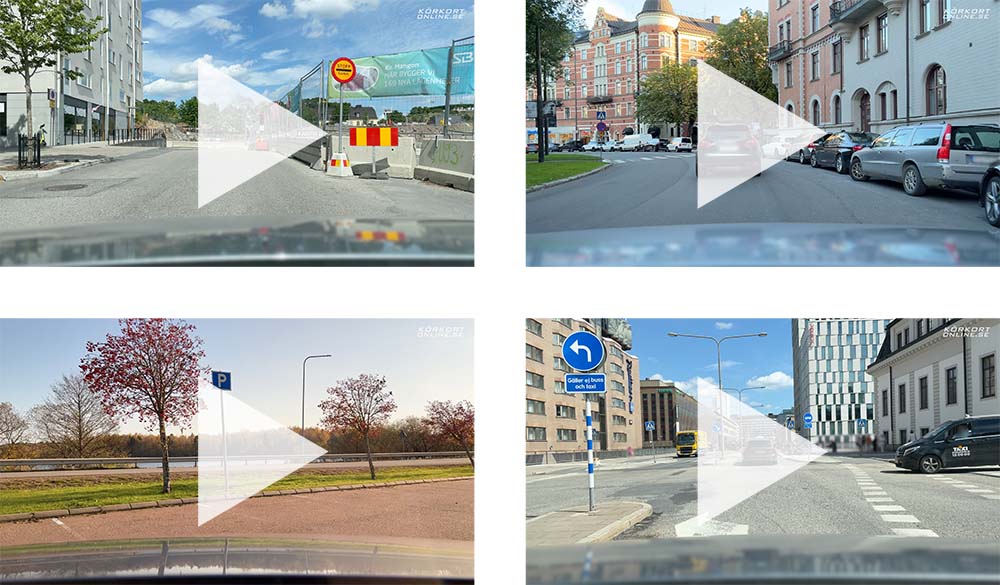Steering – the car’s steering system and performance
Oversteering
- The car turns too much as the back tyres lose grip.
- The result is a rear-wheel slide (fishtailing).
- This normally affects rear-wheel drive cars.
- To avoid oversteering, put the best tyres at the back.
Causes of oversteering
- Aquaplaning with the back tyres.
- Forceful braking.
- Forceful acceleration with a rear-wheel drive car.
- Tail-heavy car (too heavy a load at the rear).
- Insufficient air in the back tyres.
- Worn back tyres.
- Connected trailer or caravan.
- Crosswind.
Illustration: oversteering

The driver first turns the wheel normally, to steer the car around the bend.
The driver then notices that the rear wheels are losing their grip and gliding to the left, which the driver tries to compensate for by turning the wheel to the left instead of the right (so that the front wheels of the car also go to the left, in the hope of straightening up the car to regain control).
However, the grip is too poor and the rear-wheel slide continues.
Note that the red wheels always point in the direction of the road, which is desirable. If the driver had kept turning the wheel to the right in the beginning, the car would have spun much faster and harder.
Understeering
- The car turns too little as the front tyres have insufficient grip.
- The car wants to continue travelling straight ahead at the bend.
- This normally affects front-wheel drive cars. (Most new cars have front-wheel drive.)
- Better than oversteering, as understeering requires less of the driver.
Causes of understeering
- Aquaplaning with the front tyres.
- Braking without ABS brakes.
- Forceful acceleration in a front-wheel drive car.
- Insufficient air in the front tyres.
- Nose-heavy car (too heavy a load at the front).
- Worn front tyres.
- Connected trailer or caravan.
- Locked differential (the wheels are forced to move at the same speed on bends).
Illustration: understeering

The driver first turns the wheel normally, to steer the car around the bend.
The driver then notices that the car is not reacting sufficiently, so turns the wheel more sharply.
However, there is not enough friction between the tyres and the road. Without friction, the car will remain on the same course. Here there is a certain amount of friction, which means that the car simultaneously continues straight ahead and turns to the right.
Steering system
- Power steering is a system that makes it easier to turn the wheel.
- Choppy steering probably indicates that dirt or air has entered the servo.
- A shaking steering wheel is normally caused by imbalance in the front wheels or looseness in the steering mechanism.
Electronic stability control

ESC should always be on.
A computer with sensors detects whether a wheel is spinning or if the car is hastily turned in a certain direction. The computer uses this information to calculate the best measure for resolving the situation (e.g. applying brakes to one of the wheels).
These calculations and corrections take place so quickly that the driver will not normally notice anything. The electronic systems are very good from a road safety perspective.
Different names
Different manufacturers have different names for their electronic systems. A few examples:
- Anti-skid system.
- Anti-spin system.
- DSTC (Dynamic Stability and Traction Control).
- ESP (Electronic Stability Program).
- ESC (Electronic Stability Control).
Aquaplaning
Aquaplaning essentially means that the car becomes a boat without steering. The tyres are unable to disperse all of the water from beneath it and thereby do not make contact with the road. In other words, the car floats on the water.
Wider tyres mean that more water needs to be pushed aside, which leads to a greater risk of aquaplaning.
Slushplaning is the same thing as aquaplaning, though it involves snow and slush rather than water.
Factors that increase the risk of aquaplaning or similar loss of control
- Large pools of water.
- High speed.
- Wide tyres.
- Tyres with poor tread depth.
If you begin aquaplaning
- Do not make any sudden movements with the steering wheel.
- The wheels should point in the direction of the road, so that you do not begin to skid when the grip returns.
- Depress the clutch.
- Release the accelerator.
- Do not brake.

Red: the amount of water that has to be dispersed for the tyres to have contact with the road.



